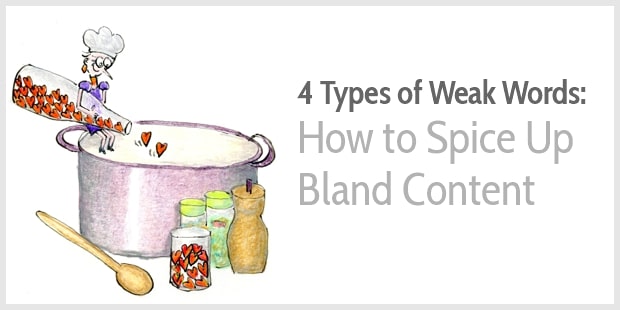 Do you ever read back a draft and wonder what happened?
Do you ever read back a draft and wonder what happened?
Red-cheeked and brimming with enthusiasm, you had written your first draft.
You knew it was good. Yay!
To celebrate, you pour yourself a glass of wine, before going to bed. Editing is for tomorrow.
But when you read your draft again …
You feel disappointed. Your writing sounds bland.
Grrrr. You can’t publish it like this.
What happened?
Have weak phrases sneaked into your writing?
They always do.
Even the most experienced writers have to stay vigilant and edit their drafts with a sharp knife and a selection of spices.
Turning bland text into sizzling content may sound difficult, but it requires only two simple steps:
- Like a chef tastes a dish before serving, you need to know when your content lacks flavor. You have to spot weak phrases.
- And just like a chef grinds a little extra pepper, sprinkles a few coriander leaves, or drizzles extra lime juice, you need to balance the flavors of your writing, too.
Shall I explain?
Let’s start with spotting bland words. And then, I tell you how to flavor up your writing. Okay?
4 must-know types of weak words
Type 1: Chewy and tasteless
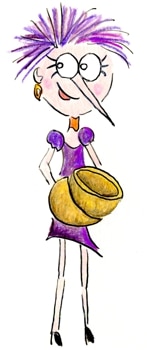 Like pineapple peel or walnut husk, you don’t want these words to turn up in your content. They slow down your reader without adding meaning. Chopping off is the best advice.
Like pineapple peel or walnut husk, you don’t want these words to turn up in your content. They slow down your reader without adding meaning. Chopping off is the best advice.
Examples:
Very, actual, in my opinion, really, just
Chewy sentence:
In my opinion, this blog post is fun.
More nutritional:
This blog post is fun.
Type 2: Stale words
 At one time these words were strong and powerful. But over time, they’ve lost their meaning—like stale bread.
At one time these words were strong and powerful. But over time, they’ve lost their meaning—like stale bread.
Examples:
Ultimate, stunning, amazing, wonderful
Stale headline:
The Ultimate Guide to Developing a Writing Habit
Tastier option:
A Lazy Girl’s Guide to Writing Habits
Type 3: Doughy words
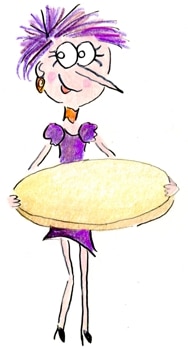 These words have some taste, but they aren’t particularly flavorsome. In moderation, they’re okay, but use them too often and you get a pizza with a doughy crust and no toppings. The cook’s advice is to use with care.
These words have some taste, but they aren’t particularly flavorsome. In moderation, they’re okay, but use them too often and you get a pizza with a doughy crust and no toppings. The cook’s advice is to use with care.
Examples:
Them, it, there, he, and other pronouns
Is, are, was and other forms of to be
Doughy sentence:
There was a weird Dutch girl who I met on LinkedIn.
Tastier option:
I met a weird Dutch girl on LinkedIn.
Type 4: Words with low nutritional value
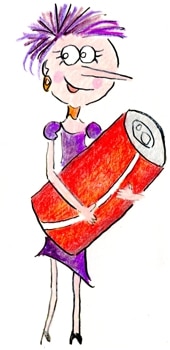 A coke quenches your thirst and appears to give energy, but its nutritional value is low.
A coke quenches your thirst and appears to give energy, but its nutritional value is low.
Words with low nutritional value are similar. They seem to have a meaning, but their meaning is weak. For instance: What is a good blog post? Do you mean it’s entertaining, engaging, or useful?
Or how do you define a successful business woman? Does she have a six-figure income? Oodles of leisure time? Or does she inspire you and make the world a better place?
Words like good and successful are problematic because they can be interpreted in many different ways—they’re not specific enough.
Low nutritional value:
She’s a successful writer.
Tastier option:
She makes a living from writing while working only 10 hours per week.
So, cross out a few weak phrases, and your writing instantly becomes stronger.
But want to add some spice and zest, too?
3 types of flavorsome words
Type 1: Sensory words
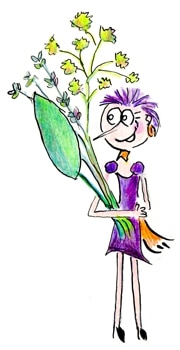 Your brain processes sensory words almost as if you taste a sweet cake, as if you see a dazzling display of colors, as if you feel a rough texture.
Your brain processes sensory words almost as if you taste a sweet cake, as if you see a dazzling display of colors, as if you feel a rough texture.
Examples of sensory words: Dazzling, flavorsome, gloomy.
A rather bland sentence:
These long-lasting cabinets are made from the best material, guaranteed for 10 years.
A more sensory option:
These cabinets remain squeak-and-creak free, guaranteed for 10 years.
Type 2: Peppery verbs
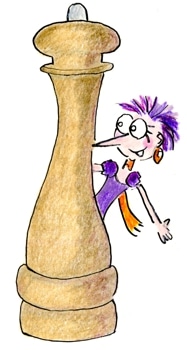 Peppery verbs are precise and concrete. They help readers visualize ideas.
Peppery verbs are precise and concrete. They help readers visualize ideas.
Examples of peppery verbs: To shout, to scribble, to plod, to glide.
A rather bland question:
Would her audience be interested enough to read her blog post word by word?
A tastier option:
Would her audience gobble up her words?
Another bland question:
Do weak phrases feature in your writing?
A zestier option:
Have weak phrases sneaked into your writing?
Peppery verbs express movement, emotions, or sensory appeal.
Type 3: A dash of onion emotion
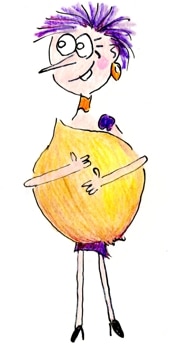 When reading emotional words, your brain sends signals to your body—almost as if you’re experiencing that emotion.
When reading emotional words, your brain sends signals to your body—almost as if you’re experiencing that emotion.
So, reading positive words activates our smile muscles while reading negative words engages our frown muscles. You may not notice it, but we feel what we read in our bodies. It helps us understand what we’re reading, and maybe remember it as well.
Examples of emotional words: Smile, laugh, embrace, kiss, joy
A rather bland opening for this blog post:
Imagine this:
You’ve written a first draft of your next newsletter.
It was hard work but you know it’s good.
Then the next day … when you read your draft again …
It’s not as good as you thought. You can’t publish it like this.
More emotional:
Red-cheeked and brimming with enthusiasm, you’ve written your first draft.
You know it’s good.
Yay! To celebrate, you pour yourself a glass of wine, before going to bed. Editing is for tomorrow.
But then, when you read your draft again …
You feel disappointed. Your writing sounds bland.
Grrrr. You can’t publish it like this.
Quite a difference, eh?
How to find more flavorsome words
Our word choice is often habitual. We think of the most common words first.
So, how do you flavor up your writing?
Start by paying attention. Notice the words that are common, and the words that are more sensory, precise, and emotional, or more interesting (like one of my favorites: pizzazz).
Pay attention to the words you’re using but also to the words you’re reading. Which words stand out to you?
Next, when you’re editing a text try to replace a few bland words with more tasty options:
- Borrow words from a different field. For instance, I write about writing, but often borrow words from cooking. You’ve seen me doing this in this post, right?
You can write about business, and borrow words from sport. Or write about marketing, and borrow words from dating or parenting. Borrow words from any field that you’re familiar with. (And for an extra injection of creativity, try this fun exercise.)
- Use a thesaurus or ask ChatGPT for alternative words. I find a thesaurus more useful. Try Wordhippo or Thesaurus.com.
- Create your own lists of favorite words—you may find some inspiration in my lists with 75 sensory words, 351 strong verbs, and 172 power words.
Editing works best when you see it as playing with words.
How to make stale content sizzle and shine
When a cook develops a new recipe, she doesn’t know exactly how many spices to add. How many drops of lime juice? How many spoons of fish sauce? Coriander leaves? Chili pepper? A hint of ginger?
To find the perfect balance of flavors, she tastes, adds spices, and tastes again.
With writing, it’s the same.
Read your content aloud. Hear how it sounds and spot the bland phrases.
Sprinkle your favorite words. Try a few exotic spices. Stir and taste again.
To create your signature dish, experiment with different flavors until you’re happy.
Enjoy!


Dear Henneke,
I would like to thank you for taking the time and effort to provide us with your experience and practical advice in writing texts. I’m not very good at English, so I often use Google Translate to understand every word I read from you.
I have been receiving your newsletter for years, I don’t always manage to study it, but I have a folder in my mailbox where I collect everything from you.
I am a Bulgarian language teacher and I even use some of your tips in my own language when I explain to children how to write impressively.
Thank you for everything over all these years! Stay healthy and let God be with you!
Dear Dessislava,
What a lovely comment! Thank you for taking the time to write it.
I know you’ve made an extra effort as English is not your first language, and I appreciate that.
I’m glad to know that my tips are useful when you teach children. That’s so lovely.
Unami-“pleasant savory taste”- is how this post coats my brain.
Thanks.
Lots of nutritional tidbits to chew on, savor, digest, gain strength and energy from.
Spooky timing, as my can’t put down current guilty pleasure book right now is,
“What I ATE in one year {and related thoughts},” by Stanley Tucci.
Seems to align with your way of thinking and being.
He based in London. Do you and Henrietta ever run into him when you’re out clubbing at places like Annabel’s or The Groucho Club? You’re both members right?
Anyways, Thanks again and I hope this message finds you well.
Haha! Henrietta and me clubbing?
We’re much more boring in real life than here on the blog! 😉
I’ve not read Stanley Tucci yet but you’re making me curious!
And I love umami, both in food and in writing.
Thank you for your lovely compliment, Phil!
I double dog, no triple dog, no triple dog dare infinity + 1, no take backs, dare you to put down,
“What I ATE in one year {and related thoughts}”
by
Stanley Tucci
Once you start reading this book.
Happy gray as a slug,
slick as gorilla snot,
ice storm Sunday morning from across the pond.
That sounds like a good dare!
Do you think this book is better than Tucci’s book “Taste”?
Sending a few rays of sunshine to cheer up your day.
I often quote the intro to a critique I graded, as a teacher, decades ago:
“If you want my opinion, I think…”
I had to inform that poor student, “If the assignment is to write a critique, you must not begin with “if you want my opinion” nor with “I think”. You’ve been asked to give your opinion, to proclaim what you think. Why not begin by spitting it out? Why not begin with the uniqueness that is YOU?
This student was insecure inside his own thought world. Once I told him it was good to have personal understanding and to share it when asked, he improved.
How often we tremble behind bland verbiage or loquaciousness, when we feel unconvinced of our worthiness! We use words as a costume, complete with a mask, to appear to be what we aren’t.
That is such a sad beginning to an essay; it sounds like the writer doesn’t believe anyone might be interested in his opinion.
But I’m glad that with your guidance he improved. That’s fab!
And yes, we can use words as a costume, complete with a mask, to appear to be what we aren’t.
It’s so interesting because we can also use words to connect with our inner voice and discover who we are and what matters to us.
Thank you so much for stopping by, Katharine. Always good to see you.
Being here elevates my thinking. I suffer when I don’t show up. 💗
You’re too kind. ❤️
This is exactly what I needed. I am a “really and actually culprit”. No more. Thank you again
It’s really easy to use actually and really a lot! And you don’t have to cross them all out. Sometimes, these words can add stress or help create a more conversational tone. Using them with a clear purpose is fine. I use the occasionally, too.
Wow, this is a feast of ideas! Henneke you seem to revel in the “gustatory” sensory style — not commonly used by writers outside the cookery world! One of the many reasons your posts are so compelling for writers… they’re tasty recipes for success.
NLP (neuro-linguistic programming) posits that we all tend to favour one sense over the others when we experience the world around us. The most common primary learning style is visual, followed by those who prefer listening to, rather than reading, information. Newsletters versus podcasts. Digital or printed books versus audio books.
Sensory writing – how things look, sound or feel – engages all readers on a deeper level, whatever our personal sensory style, because it’s evocative.
Only a small percentage of people are primarily gustatorial in how they perceive the world… but we all love eating, so using foody words is a deliciously yummy and creative way of engaging readers’ senses.
I love cooking so much because it’s such a multi-sensory and mindful experience for me. I love to cook with colorful ingredients; I love the sense of motion when chopping, slicing, and stirring. And then how the smells mingle together. That’s before we get to tasting which was more the focus of this post.
Visual is also my dominant sensory experience.
This article is tasty. I’ve learned, unlearned and re learned.
Thank you.
That’s great. Happy writing, Babalola! I appreciate your comment.
Very interesting.
What did you find most interesting, Eloisa?
I can’t wait to put these ideas into action today! Thank you.
Great. Have fun!
Read this article early this morning after spending some time in my Bible. You’re so spot on Henneke, thank you. The Bible is choice reading to spot a creative economy of words and your piece today lit up my mind! Great job!
Thank you, Hank. I’m glad you enjoyed my piece.
Can we be friends? The Bible is such a good teacher of writing especially the Psalms.
Lovely… no… Gorgeous! I woke up with a poem in my head and wrote it down. But then I read your post and ousted a few bland words. Thanks for the work you do.
Ohhh, that’s such lovely feedback. Thank you, Jack!
Every day my word choices sparkle more like polished diamonds thanks to you. Can’t express enough appreciation for your writing education. A million claps.
Your comment makes me happy, Donna. Thank you. Happy writing!
Interesting articles indeed. Thank you for the Chef analogy, your art is so lovely 😀
Thank you. I’m glad you enjoyed the analogy and my drawings 🙂
I am in the middle of writing an email newsletter for a client and I have scratched my head for the next beautiful line of sentence to use.
When I couldn’t find one, I rushed over to read from Henneke. I think I should let you know that I smiled all through.
I felt like an experienced cook again.
I’m off to chop off the bland parts of the meal I’m cooking. Thank you, Henneke.
Thank you so much for your lovely comment, Amy. Happy cooking! 🙂
Thank you, Henneke! The chef analogy was a fresh way to deliver this information. You really made it easy to digest.
I’m glad you enjoyed the analogy, Kevin. Happy writing!
Getting the nerve up to publish my first book….found your cooking analogies both humorous and educational. Nothing bland here!
Thank you, Barbara. I’m glad you enjoyed this. Good luck with publishing your book!
I love your articles I’m interesting in taking copy writing lessons or finding a mentor. Please let me know if you’re available and your rates.
Hi Jon-Paul
I don’t offer any one-on-one coaching at the moment but I’ve just launched my copywriting course: https://www.enchantingmarketing.com/copywriting-course/
“But real authorities peel off redundant layers to get to the core of their message” sexy with lots of
memorable punch.
Vivid and very precise.
Have started sprinkling your magical tips on my bland webpages to wake them up. Your impact doesn’t have basis for comparison, Henneke…
Finally, I found the guru!
Great! Thank you so much for your compliment, Paul. I’m glad you’re enjoying my writing and, even more importantly, that you’re implementing my tips 🙂
2020, still relevant and educative. thank you Henneke
Thank you, Julie. Happy writing!
Just Wow. After reading this, I am definitely going through my article again and reading out loud to chop off bland and stale words.
Thanks
Happy cooking, Siver ? And thank you for stopping by again!
Wow! Never viewed words with such a beautiful perspective. Learnt a lot, Thanks. Keep inspiring!
Thank you, Sivashanmugam. Happy writing!
Another word to add to this list: “content.” It basically means “stuff,” and its use in this piece is almost always as a synonym for “writing,” which would have been simultaneously more specific and less redolent of corporate jargon.
People do not write merely to fill a container. People write to communicate ideas. Calling the written word “content” privileges the container at the expense of the writing and ideas the container was created to contain.
Judging from the many appearances of “content” in the article AND the glowing comments that followed, I concede that this is an uphill battle.
Yep, I think it’s an uphill battle. While I understand your view on the word “content,” I feel its meaning has evolved as content marketing has become more popular. Some freelance writers even refer to themselves as content writers.
Hello Henneke–your tart and tangy tips are already adding tantalizing uplift to my reviews on TripAdvisor and Goodreads. Yes, chop off bland and doughy scraps. Embrace zest and zing.
My nominations for junk words?
Sort of. Kinda/kind of. The. You. Get/got.
Nice one Henneke. I thoroughly enjoyed and learnt a ton of lessons. Keep writing such awesome knowledgeable posts.
Thank you, Farhana 🙂
Dear Professor Henneke,
Thanks for the eye openers cooking illustrations,
I love cooking and the idea of using this method for your teaching, energies my personal curiosity. Now, I can’t wait to try my practical exercise, by the use of the examples of the cooking and dance floor to express my messages.
I wish I could float with words, on the computers like the imaginary dancer, on the dance floor.
It’s been an interesting class, every page brings me to another revelation of a new information, on the subject, I love it.
Thanks so much ma.
… Paula.
Happy dancing, Paula 🙂
I enjoyed reading this post. I will certainly add these helpful tips to my writing.
Thank you, Carol. Happy writing!
Great content! I really enjoy your writing. It is so clear and concise.
Thank you, Valerie. Happy writing!
I loved your article esp bland words section. I am a newbie and I use lots of bland words. I am bookmarking this website and everyday before I start to blog, I will read your blog for do’s and don’t.
I’m glad you found this post useful, Kamya. Happy writing!
Every time I come across your blog posts, I feel urge to bookmark them. They’re like jewelry boxes, with each one carrying value. Really awesome work.
What a lovely compliment. Thank you, Aditya.
I was about to give up my blog due to my poor writing, but this article inspired me again and made me believe I can get better. Thank you.
Of course, you can improve your writing skills. Don’t give up!
I find the analogy used to compare writing to cooking relates to my life well – thank you!
I love cooking analogies 🙂
I loved this! The whole comparing it to cooking made everything make a lot more sense now!
Thank you, Ariel 🙂 Happy writing!
Thank you Henneke. Love it. I guess being more human in our writings (more emotion, more senses, more compassion and touching) makes them more alive, and resonate better with other humans. And your writings are the best example.
Yep, especially corporate writing often doesn’t sound human at all, as if robots have written it.
Thank you for stopping by to comment!
I love how you break down writing into these lovely lessons. So helpful.
I love breaking big topics (like writing!) down into a series of small questions. If I can answer one simple question in a blog post, I’m happy. Thank you for stopping by, Darren!
Wow! Thank you so much for this post. As a new writer trying to find my voice this has been beyond helpful! 🙂
You’re welcome, Kathy. Happy writing!
You don’t have to have Mr.Webster at your side to make good copy. People generally like to read words they use on a daily basis. I was taught to “keep it simple, stupid.”
White what your audience is interested in learning. (Notice:I left the word ‘about’ off at the end of the sentence because other than poor grammar, it is redundant.)
Let’s not get too critical of each other, though. I can enjoy your writing without getting nit-picky about every little misuse of the queen’s grammar. Some of you-all Texans say y’all; while others say yawl. You’re just careful to not say you’se guys as many Northern friends do. Luvya.
I don’t know how you do it, but ma’m you do it quite well. I’m going to have to go back and do some serious editing this weekend. Off to see if you have any posts on guest blogging (that’s how I found you_
Hi Nia, Welcome 🙂
I haven’t written a lot about guest posting. You may want to check out this post I’ve written for Boost Blog Traffic about how I used guest posting to launch my freelance career: http://boostblogtraffic.com/online-career/
Henneke – you don’t cease to amaze me with your blogs overflowing with originality and simplistic genius! And you don’t allow yourself to become inebriated with the eloquence of your own verbocity (that’s a quote from an old showman!).
Keep it up Henneke! We all seem to be fascinated and titillated with every post that you contribute to mankind!
Yep, that’s right. No inebriation. No verbosity.
Thank you for your lovely comment, Chaim!
Henneke, thanks for writing this; a great refresher! I think words such as “enterpreneur” “hacks” and “hustle” are getting overly used to the point of losing effectiveness.
Really glad to have come across you via Elna Cain’s website where she listed your site as one of her top 10. Will be checking in regularly from now on 🙂
Jennifer Nini
Founder
http://thesocialcopywriter.com
Hi Jennifer, Nice to meet you 🙂 Thank you for stopping by!
Aspect, feature, –are these not colourless words ? Henneke, what do you think ?
This is about the style of writing. People are obsessed with grammar and they tend to ignore style. Henneke seems to ignite some interest in readers who have so long been disregarding the significance of style. I would like her to incorporate the vague, abstract, colourless word “Thing” in to the rejection list.
Sure, and let’s add “stuff”, too.
Ok, I started out thinking “this is a fun piece.”
Then, I was amazed. Your REAL examples of sentences that were previously dough-y or stale which you then shaved and brought to life were, well, ah-mazing.
I think if every new writer was to read this, it would give them the advantage of 6 months of learning it themselves. I know it took me at least that long to learn to SHAVE down my words and get my copywriting “tight”. The one thing I see so many new writers not fully grasp is this concept, right here.
I will be sharing this as a resource. Great piece here.
Yes, tightening copy is a difficult skill to master, and a skill that we need to keep refreshing all the time. Because those weak phrases keep sneaking back in, don’t they? 😉
Thank you for sharing and for stopping by, Julia. Nice to “meet”!
By far the most deliciously divine blog post that I have read in a very long time 🙂
I thought I heard someone licking her lips 😉
Nice to meet, Trish!
Love the beautiful recipe… And the drawings…. Will add some more flavors to my stupid writing…
Welcome, Kirti. Nice to “meet” 🙂
Don’t be so harsh with yourself. I’m sure your writing isn’t stupid!
Hello Henneke – I absolutely love this article and your writing style. I find it refreshing but also to the point. I was wondering if you have a favorite resource for dynamic words ideas. Like if you’re stuck on a boring word, and you needed to freshen it up.
A normal thesaurus is one option – but not very creative. And even then it’s just a word-for word substitute.
I have one book to help with Verbs – Actions: The Actors’ Thesaurus. But wanted to hear what you suggest.
Thank you :o)
Hi Anita – I use thesaurus.com a lot. But I also have my own list of favorite words. It often helps to “change the scene”, so if I’m looking for an alternative for “improve a sentence”, I could think about cleaning the house, and come up with “polish a sentence”, or I could think about cooking, and it becomes “add flavor to sentences”, or traveling makes it “write a smooth sentence”, etc.
I hope this helps!
Thank you Henneke, this is an excellent post. I love it. Your bit-sized tips are super useful. I started my blog The HR Rabbit Hole 8 weeks ago, so this just the brainpoke I need. I can already see how I can draw on these tips to help my clients wake up criminally blah content in their employer brand and recruitment marketing material. A few dashes of hot pepper sauce perhaps?
Yep, hot pepper sauce sounds good! 🙂
Thank you for stopping by, Nicole
Henneke,
I love your work and thank you for your generosity. You post freely and your books are bargains.
I’ve tried to implement your tips and had some success. Most word choices you suggest seem to revolve around food. I’m having a struggle to find enticing phrases that are not food oriented. Also, in examples you often give such as “the lazy person’s way to go”, is that effective or dangerously close to alienating business clients? You know this stuff, I merely am trying to learn. Thank you, Chris
Thank you so much, Chris.
You don’t have to go for food-related words. When you write about company culture, for instance, can you borrow phrases from team sports – like pep talk or rowing in sync? When you talk about speaking in public, can you borrow words from dating (seducing your audience, holding your listener’s gaze) or magicians (mesmerizing, fascinating)? The key is to use words that paint a vivid picture or make your reader feels something. You might find this post helpful: https://www.enchantingmarketing.com/how-to-choose-the-right-words/
No rule exists about what works and what doesn’t work – it depends on your audience (and your voice). By making stronger word choices, you may alienate some people, but you bond stronger with your core audience. For instance, I wrote “The Dilly-Dallier’s Guide for Developing a Writing Habit” – some people loved the title, but I know at least one person unsubscribed because he thought the headline was stupid. This is fine with me. The same happens with my snackable course – it’s not for everyone.
Thank you again Henneke,
You are right on the money. You can’t please everyone. I must try to develop the use of spicier language. I tend to express things too clinically out of desire to be honest. But adding flavor doesn’t mean the words are not honest.
Hi Henneke,
Just discovered your blog via Twitter. You offer rich and precise content which explains everything a person needs to know about writing. I will look into your other posts, and I feel this blog is a valuable discovery.
By the way, I’m also starting a blog mainly for our customers but plan to enrich it with different topics on Customer engagement, Customer support, Sales.
Best regards
Roland
Welcome, Roland. Nice to meet!
Your topics sound great for a blog. Lots of opportunity to teach more companies to improve customer experiences. 🙂
Expert web developer sucks at basic copy writing….
“4 Types of Weak Words: How to Spice Up Bland Content” taught me to spice up my bland copy with more flavorful content.
Thank you!
Yay! Here’s to more flavorful content 🙂
Thank you for stopping by, Courtney.
Hi Henneke, I’m taking a lot of notes here because I love your writing but I still have one question:
What are your thoughts on using these recommendations on a different language?
I wrote a few exercises in Spanish to see if I could get some sort of the same result (impactful meaning using short sentences) and it seems like it would work.
Sergio
Hi Sergio
If you read your content aloud and it sounds good to you, then I’d say it works. I don’t speak much Spanish, but I know the same principles apply to Dutch. I’m imagining it would work for most languages.
Good to see you again!
Awesome article….. Wait, I mean: An exceptional guide for bloggers like myself. The examples are effective and the consistency of the “cooking” metaphor supports the message strongly.
Thanks for sharing.
You’re a quick learner 😉
Glad you enjoyed the post, Anthony. Thank you for stopping by.
I love your cooking metaphors! They make writing seem even more fun than it already is.
And they add clarity to the writing process at the same time. My re-writing can definitely use some exotic herbs that spice up my posts.
Thanks for the wonderful advice you keep giving us.
I think first drafts are inherently a little bland. I do need to add some spices when I edit, too. I can’t write interesting and engaging content in one go!
Thank you for stopping by, Nadia. Glad you enjoyed the cooking metaphor!
I love the illustrations, Henneke! Thanks, this is helpful for people like me who writes on a daily basis. I gotta say it’ s hard that I almost always experience writer’s block. But as you’ve said, a few garnish will do. Will take your suggestion to read it aloud!
Cooks don’t suffer from a cook’s block 🙂
For me, the way to overcome writer’s block is to accept that writing is a process. It doesn’t matter how shitty a first draft is, because it’s part of the process. Write down any words, and re-arrange, rewrite, and mix in a few spices while editing.
Sometimes it helps to set a timer to try to get that first draft done.
What a delicious post. The illustrations are fun. Keep ’em coming, Henneke! You do AMAZE me! Love your brain and creativity to the max! Always spot on help!
Thanks so much, Lee. I become more creative when I’m having fun 😀
Good to see you again!
hi, there Henneke.
My site is not up yet, the deadline is beginning of May, I am three months behind, but hopefully three-month better able to do it.
I love your blogs as you know. I am wondering when you are going to open your restaurant? So I can come and have lunch in an personal and happy atmosphere with interesting, tasty food.
Always love your mail. Love and Blessings
Annamarie
To me, a lot of deadlines are quite artificial – what’s more important is to continue to progress to our goals.
And who knows? Maybe one day I will open a small restaurant. I’ll send you an invite! 🙂
Boy! You are 100% correct! (You should use exclamation points only when you’re yelling?…but I WAS!)
As a long-time commercial artist and art – tickle writer, I loved your post. Let’s have lots more.
I tend to feel famished after reading one of your blog posts, Henneke. 😉 Delicious as usual. I especially enjoyed the drawings on this one.
This is something I’ve been doing myself lately – ditching the weak words and catching my tendency to say “kinda”, “sorta”, “very”… Of course I’m still a work in progress, but when I re-read after I’ve cut or changed my words it definitely feels more powerful. Thank you for reminding me why this is so important.
Yes, it’s weird, isn’t it? When I write my blog posts, I often get hungry, too. I wonder why that is? 😉
In a way, our work never finishes – we’re always work in progress. But that’s why writing (and drawing!) is so much fun.
Thank you for stopping by again, Jenna!
Hey Henneke,
this was a one of those posts that reminds us to double check our posts and make sure that we add some flavor and excitement to them. I have been getting better with my posts as far as using this power words and emotional words, but I’m still open for more suggestions. There is always room for improvement. I can definitely see the improvement from the posts I did last year!
Thanks for the share Henneke! Have a great weekend!
I can also see quite a big difference between the posts I wrote a year ago, and the posts I write now. If we continue to pay attention to our writing, then our voice evolves, too 🙂
Hope you have a great weekend, too!
I love this post! I have begun reading out loud what I’ve written, and sometimes I even talk to myself as I’m writing. I may sound like a nut, but it really does help you hear those weak areas, words, phrases, like you talk about here. Great post and thanks for the tips. 🙂
Well, if you think you may sound like a nut, you’ve not heard me chatting with myself! 😉
Hahahahaha! I’m very familiar with doing that! 🙂
Thanks Henneke. I’m editing this morning and your points are going to help a lot! Grammar is not my strong suit so your simple way of explaining things is much appreciated. Love your drawings as always:)
Glad it was helpful, Lisa!
I think I’ll keep doing hand-drawn “infographics” like this more often (but not every week!). Thank you for your encouragement 🙂
Henneke,
You’re amazing.
First off, the advice you gave is with pin-point accuracy. Weak words riddle my writing from time to time and I know it. Just reading this most made me thing about all the weak words in many of my posts … and how I have to really improve on my writing with good editing. But that’s my problem. The editing. I’m not sharp enough like a knife with it and that has to change.
Secondly, I love your drawings. From when I started following this blog, I can see how far you’ve come with regards to it .. and it just adds to this post. Really it does.
And regarding your question in the email you sent out. More drawings please. 🙂
– Andrew
Thank you so much, Andrew. I think the message is becoming loud and clear – more drawings 🙂
You can sharpen your editing knife if you write down a quick checklist of words you want to eliminate (the list above is a good starting point ;-)). Instead of doing all sorts of editing in one go, like checking the flow of your content and correcting grammar & spelling mistakes, focus ONLY on eliminating the words on your short list.
That’s how I sharpened my editing knife 🙂
One thing that helps is reading your copy out loud. Pretend you’re in front of a large, discerning, snobby audience. That helps me whittle away extra words. Good post.
A discerning, snobby audience? That would scare me off publishing my writing! But I can see it can help to spot the redundant words 🙂
I love the extended metaphor on cooking. It makes it easier to go through your copy with keeping an eye out for diction when you have something to compare it to! It also acts as sort of a “spice” to the theme of the post overall. Instead of just saying why words are bland, comparing them to things we use every day makes it come to life.
The advice to read it aloud to spot the bland words is really great too. Not only will it help you identify where you can spice it up, it will also help you find awkward phrasing or passive voice sentences.
I think a lot of people may find it a strange idea to read copy aloud, but I always make quite a few changes when I read my copy aloud. It’s the best way to spot awkward phrases, bland words, and sentences that are too long. I never publish anything without reading it aloud (and often I read it aloud twice or even three times).
Glad you enjoyed the cooking metaphor, Lucy. Thank you for stopping by.
Sure thing, Henneke! Always look forward to reading your insight on writing copy.
Henneke
Your colorful examples inspire creativity. Thanks for simplifying and making the process doable.
That’s a lovely compliment. Thank you, Susan 🙂
I just loved your post. As someone just starting out in the freelancing world, I gobble up every learning opportunity I can. You always share your ideas and experiences in the most engaging way so not only do I get great advice, I am also inspired and entertained. This post had to be one of your best.
Thank you so much, Monica 🙂
Dear Henneke,
I love your posts and your sound advice and I enjoy your words as much as your pictures. Thank you for your inspiration and common sense.
Kind regards from Jet.
Thank you so much, Jet! 🙂
Thank you for sharing your recipe, Henneke.
I can almost smell your dishes. And your illustrations are just as delicious.
I especially like the adding a “dash of emotions” and “garnish with personality” bit. And now, I am eager to knead the dough and get the rough draft out so I can add in some spice.
I’m the type of cook who doesn’t like kneading dough. But I love the process of tasting and adding spices to my dishes.
I need to get a first draft out of the way as quickly as possible as I don’t like writing it. And then I can enjoy the process of editing.
Glad you enjoyed this, Louisa 🙂
Did you really can’t draw a line before you started drawing?? How did you find time to do all of these things? It surely takes you loads of time? Do you get enough sleep time??
As for writing, I have one more tip to share. I believe that writers are actors too, when they write, they imagine themselves being in the situation and then write down all their 5 senses experiences.
Well, I could draw a line and a circle, but not much else. I didn’t draw since school, and started drawing again nearly two years ago. Daily practice makes a big difference!
And you’re right – it did take a lot of time. About three hours for each of the two drawings. I struggled to get the composition right, and then coloring all elements and drawing the lettering took time. But it was a fun project. It wasn’t work! I had started it for my drawing course and then decided to use it here. 🙂
I do try to get enough sleep. But I hardly watch TV and I don’t have a Facebook account 😉
PS And that’s an excellent tip on imagining the situation and then writing down the 5 sensory experiences! Thank you.
Henneke, this post had me smiling as love to play with food. I am a raw vegan and make all my meals with my own hands, so I was relating to what you were saying with delight 🙂
Thanks for all the tips on grammar and getting rid of unnecessary words, I stand guilty of this 🙂 learnt a lot from you post and will take note and implement.
Can I ask you about your drawings, they are lovely and add humour. I would also like to do the same for my blog, how are your drawings done? Do you draw them yourself ? if I presume you do them in some kind of software or on paper?
Telling me you were smiling while reading this post, is the biggest compliment you can give me. Thank you, Jane.
I draw first in pencil, then use ink and nib (or in this case Micron pens). I then erase the pencil lines and add color with colored pencils (Derwent Colorsoft – they’re quite waxy so it’s easier to get vibrant colors). An old-fashioned and simple way to create the images. I’m not a PhotoShop user and I like the real feel of paper & pencils.
I scan the images and re-size them before uploading them to WordPress.
Have fun!
Henrietta is really doing good drawing recipes. I hope she continues. When she finishes with her her children’s book she could write a basic English grammer. She is the only person I have ever read who has been able to sneak up on a person and teach grammer witout ever using the word. Outstanding!
We have new blooms, new bees and Mr Bluebird checks out his new condo behind our house.
http://www.poetslovebirds.com
P.S. How is the children’s book going?
Haha! A grammar book? But that’s soooo boring!
Your birds are so beautiful.
Unfortunately, I’ve not made any progress with the children’s book yet. I could blame Henrietta. Or I could say I’m busy with my course. But the truth is I’ve not figured out where to start. In the meantime, I’m just fooling around and drawing some silly recipes 😉
I love your drawings, they are funny and cute and makes your writing more tasty.
Best regards,
Cornelis
Thank you, Cornelis 🙂
I’m glad I read this today. Thanks for the lesson.
You’re welcome 🙂
Loved your appetizing post. Content has to be tasty to compete with the use of images today.
Thank you, Sandy!
Hi Henneke,
Truly enchanting!
As we say in India, this is a “1 + 1 = 11” masterpiece.
So please keep writing and drawing.
What tools did you use to draw and to paste your drawings in this post?
I drew with Micron pens and colored pencils. Usually I use a nib and ink instead of Micron pens.
I scan my drawings, re-size them and then upload them to WordPress. A pretty basic process, no fancy PhotoShopping required 😉
Glad you like it, Rohi!
I want to get rid of bland words.
When I right-click in Word and look at synonyms, most often they are not tastier.
I often use thesaurus.com.
But the best trick is probably to pay attention to the words your favorite writers use, and create your own list you can refer to when you feel stuck.
Great Post! I enjoyed the cook metaphor. It added color and spice to your post. And I agree with the other comments, your drawing is getting more vivid and precise.
Thank you for the reminders. Those bland words creep in so easily:)
You can imagine I checked and double-checked this post to ensure I crossed out all the bland phrases. They do creep in easily 😉
Thank you for your compliment on my drawing. It’s been so much fun to create this!
You whetted my appetite for your illustrations and recipes. Eagerly awaiting scrumptious appetizers, main courses and desserts.
Looks like I’m cooking a whole banquet soon 😉
Thank you, Marge. I appreciate your feedback!
Scrumptious, succulent and delectable. Mmmm..
Love the recipe analogy and the drawings.
PS. I think you’ve drawn Carrot & Coriander soup as your featured image?
PPS. Can I have a rant about the overuse of the word….Amazing! Sheesh..
Yes, you can rant as much as you like 🙂
And yep, you might be right – I think Henrietta might have cooked carrot and coriander soup. It’s the right color for that, isn’t it? And I’m pretty sure there’s a hint of ginger. It smells good! 😉
You blew my mind with this new post. Everything was scrumptious: from the message to the illustrations.
Personally I love art and can never have enough of it. Seeing how you creatively combined art and copywriting skills delighted me immensely. I have to say, every since I found your blog, I have applied almost all advise I get from you. And my writing has improved immensely. Initially, I could never fathom why my posts seem to blend into the “me too” set of blogs littered on the blogosphere.
Even though I am a writer, your teachings have opened my eyes to the flaws I make and helped me take baby steps in improving my writing in such a way as to attract an audience.
Thanks Henneke and please do not stop the drawings, they make your posts so much more colourful and distinctive.
That’s great to hear, Chioma!
Keep writing 🙂
PS Usually my posts start with text and then I do an illustration before a final editing round. This time I started with the illustrations. That’s probably what makes this post more colorful.
Scrumptious post Henneke!
Thank you, Kayte! 🙂
Henneke, I see you and Henrietta have been cooking up a storm in the kitchen. Yes, I love your recipe style (and especially love how you’ve textured your drawings. The parsley flakes in your soup and moldy bread caught my eye.) You had me smiling all the way through this post.
Henrietta and I love our kitchen experiments. Glad you enjoyed it, too!
And yes, I’ve been learning how to use different colored pencils to create a more textured effect and more color depth. Love playing with my colored pencils. I think I’ll never grow up 😉
Wonderful post with delicious illustrations.
Keep ’em coming!
And the examples are spot on.
Letting the post simmer a little before I edit it, helps me a lot in making it spicier.
Thanks Henneke for a yummy post!
P.S. I hope google wouldn’t classify your blog again as a cooking blog 🙂
Good chefs like to leave their soups … uhm … writing simmer for a while!
I think Google has figured out by now that this is not a cooking blog and not a cycling blog either 😉
🙂
I adore your drawings! And there sure is a hell of a lot of ‘Oomph’ in this post 😉 Loved reading it!
Thanks so much, Astrid 😀
Scintillating article. As usual. Thank you.
Now, that’s a yummy word: scintillating.
🙂
These tips literally blew my mind. You illustrated me in a simple way just like a chef serving a meal.
I usually use those bland words, now I know where I should chop that words off. Thanks for the tips.
I love simplifying things 🙂
Glad you enjoyed the tips, Busyra!
I love this post so very much. The illustrations ROCK. I now wish I had time to draw and write about copywriting and content. Well done! 🙂
Thank you so much, Shannon.
Perhaps think about what you can do less so you can make a little time for drawing and writing? Even finding 10 minutes gaps in a day can help you get into drawing daily.
Good morning, Henneke!
What a delight this was to read! I laughed and enjoyed the cooking parallel so much, since I cook all our food and invent my own recipes constantly. I especially noticed a change in your drawings; you seem to be mastering facial expression and the improvement is a joy to behold. And the composition is advancing in difficulty. I love the knife as a frame for the rest of the picture, and how the coriander draws the eye across the picture. Good job!
Also, I did catch the meaning of the words and hope to cook up spicier post soon. Ha.
I had to make quite a few sketches to be able to get the composition right! But it was so much fun to do.
Glad to hear you notice an improvement in my drawing skills. Thank you so much, Katharine. 🙂
Thank you again Henneke for these tasty morsels.
Do think of you as I write stuff these last few weeks. Getting better. Sometimes slip back into old habits – my worst being long sentences!
Lots of line spacing helps too.
And now you show you can illustrate too – is there no end to your creative talents?!
Cheers, Caroline
That’s great to hear, Caroline. Keep chopping those long sentences up 😉
I’ve found a lot of similarities between drawing and writing. When you’re able to draw a picture explaining your post, your writing becomes more vivid, too. And most of us think, that talent defines whether we can write and draw well. However, with some practice everyone can learn how to write an interesting blog post as well as learn how to draw simple cartoon images.
Mark’s comment is spot on, but while we’re at it, let’s get rid of redundancies, such as refer back, continue on, raise it up, lower it down and many more. Back, on, it up and it down just clutter the sentence; they don’t add anything useful and they teach your readers bad English.
There is precious little of the English language left, and I fear that texting will continue to make things worse. Time spent editing such expressions will provide the same amount of information in fewer words, making it more likely the post will be read. Isn’t that a good thing?
Yes, agreed. Those phrases are redundant.
As you say, it takes time to edit and to eliminate all the fluff from your writing, but it’s worth it because the reader experience improves.
Thank you for stopping by, Michael.
Again, great work Henneke. Big fan here.
You really are a helpful angel for new copywriters like myself. And not to mention, cute. Looking forward for your next post!
Thank you so much, DH 😀
That was a fun filled flavorsome post Henneke. As usual, your drawings are entertaining (and getting better). They’re your distinctive signature to a post, so I say draw more!
If I may add to your list on Stale words, I’ve had enough of “awesome”. Everything is so so awesome.
Yes, I agree – awesome is stale, too. How often do we feel in awe, filled with wonder, open-mouthed and lost for words? Quite rarely, but still everyone calls everything “awesome.”
Thank you for your compliment, Mark. I’ll keep drawing 😀
I would also add the variation “awesome sauce” to the stale list, Mark. It was cute when I first read it, but the shelf life was very short.
Oh yes! You won’t find a recipe for awesome sauce on Enchanting Marketing 😉
Lol I’m so guilty of this. Whether writing or in real life. It’s something I know I have to change for sure.
To answer your question, I would love to see more of your recipe illustrations 🙂
The way you used the warm, spicy colours in the second one gave it oodles of visual appeal.
You used an excellent analogy and fleshed it out with lots of examples as always. I hadn’t thought of “there was” as as a doughy option, but your post changed my mind.
Thank you so much, Alison. I also like the second illustration best 🙂
And yep, let’s get rid of a few more doughy “there was” phrases. 😉
Love them drawings!!
Yay!
Thank you 😀